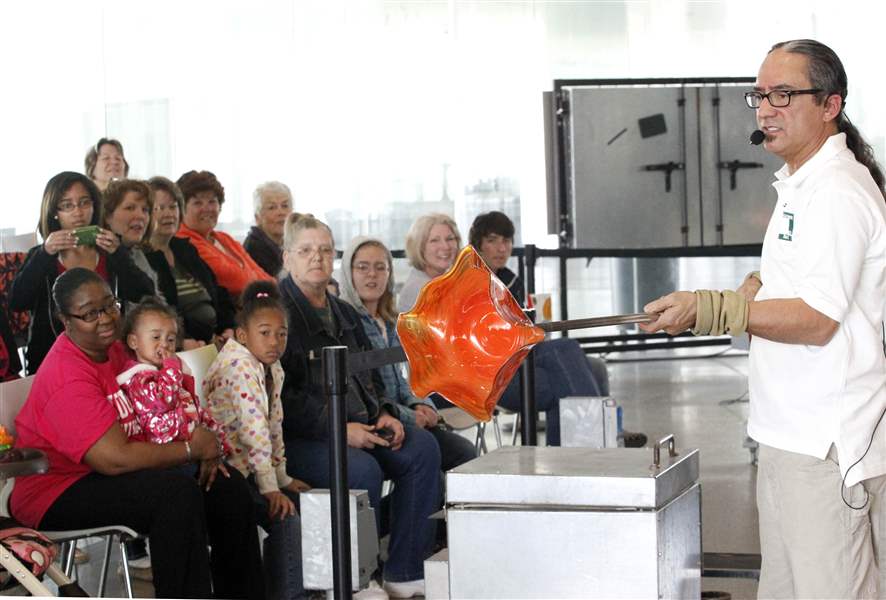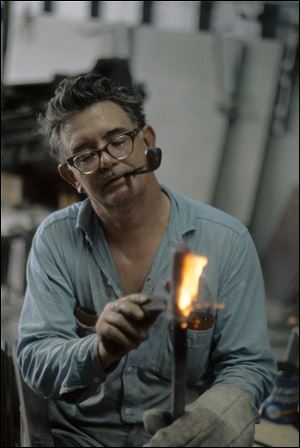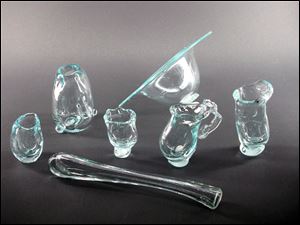
GLASS ART SOCIETY
The evolution of studio glass: A timeline
6/10/2012
Leonard Marty, master instructor of glass at the Toledo Museum of Art, demonstrates how to make a bowl recently at the museum's Glass Pavilion hot shop.
the blade/amy e. voigt
Buy This Image

Leonard Marty, master instructor of glass at the Toledo Museum of Art, demonstrates how to make a bowl recently at the museum's Glass Pavilion hot shop.

At the 1962 workshop, Dominick Labino brought marbles that, when melted, were malleable enough to blow into simple shapes.
1940s-1950s: A handful of ceramicists use their kilns to heat glass enough so it softens and can be manipulated. They make bowls, small vases, and other items, sometimes decorating them with fired enamel. A few European artists, usually affiliated with commercial glass factories, experiment, notably Erwin Eisch in Germany, whose family owned a factory that made glass tableware. He played a key role in teaching American innovator Harvey Littleton to take a free approach to glass. In Czechoslovakia, Jaroslava Brychtova experiments with casting glass and in the 1950s begins collaborating with Stanislav Libenský, whom she marries; their cast-glass piece, Zoomorphic Stones, wins a grand prize at the 1958 Brussels Expo.
1962: Harvey Littleton, a University of Wisconsin ceramicist who was fascinated with glass, holds experimental glassblowing workshops in March and June in a garage at the Toledo Museum of Art. Attending are teachers and students interested in the possibilities of glass. They build a small brick furnace, but it doesn't get hot enough to melt glass until Toledo-area glass researcher and inventor Dominick Labino redesigns it. Mr. Labino also brings a sack of fiberglass marbles that melt at lower temperatures. Called #475, the marbles are made from a formula he'd invented for his employer, Johns Manville Fiber Glass Corp. in Waterville. The success of these workshops prove to Mr. Littleton that glass can be made in a small studio and is, therefore, worth being taught. In August, 1962, Mr. Littleton visits Mr. Eisch in Germany.
READ MORE: Transformations -- 50 years of glass art
1966, 1968, 1970, 1972: Encouraging the new medium, the Toledo Museum of Art holds four month-long exhibits (the "Toledo Glass Nationals") to which pioneering artists send their best creations. For the 1966 show, 48 people send 240 objects, and jurors establish two categories: "free expression" (exemplified by Harvey Littleton) and "controlled statement" (exemplified by Dominick Labino).

The seven greenish-blue glass vessels recently acquired by the Toledo Museum of Art are the work of two first-time glass blowers who happened to be in attendance at the famed March 1962 Toledo Workshop.
1971: Pilchuck Glass School in the foothills of the Cascade Mountains in Washington is established by Dale Chihuly with Seattle art patrons John and Anne Hauberg. It becomes the single most influential place for people who want to learn about glass. Also important are the Penland School of Crafts in North Carolina and the Haystack Mountain School of Crafts in Maine.
1960s-1970s: Glass programs, usually affiliated with ceramic studies, are added to universities throughout the United States. Considered the first generation, many of these men had been taught by Mr. Littleton, and several will attend this week's 2012 Glass Art Society conference in Toledo. Among the early, influential programs and their founders are University of Wisconsin-Madison (Mr. Littleton); the University of Iowa (Tom McGlauchlin); University of California-Berkeley (Marvin Lipofsky); San Jose State University, California (Robert C. Fritz); Kent State University (Henry Halem); Rhode Island School of Design (Norman Schulman); Illinois State University (Joel P. Myers); Massachusetts College of Art (Dan Dailey), and Alfred University (Andre Billeci). In addition, Ohio native Fritz Dreisbach develops a glass program as the first director of the Toledo Museum of Art's School of Art and Design (1967 to 1970). Over the next 40 years, Mr. Dreisbach becomes known as the Johnny Appleseed of glass, putting on hundreds of demonstrations around the world. Also teaching at the Toledo museum are Mr. Littleton, Mr. Schulman, and Mr. McGlauchlin.
1970s-1980s: As artists improve their control over hot glass, they build tools and experiment, coming up with hundreds of technical innovations and glassworking methods.